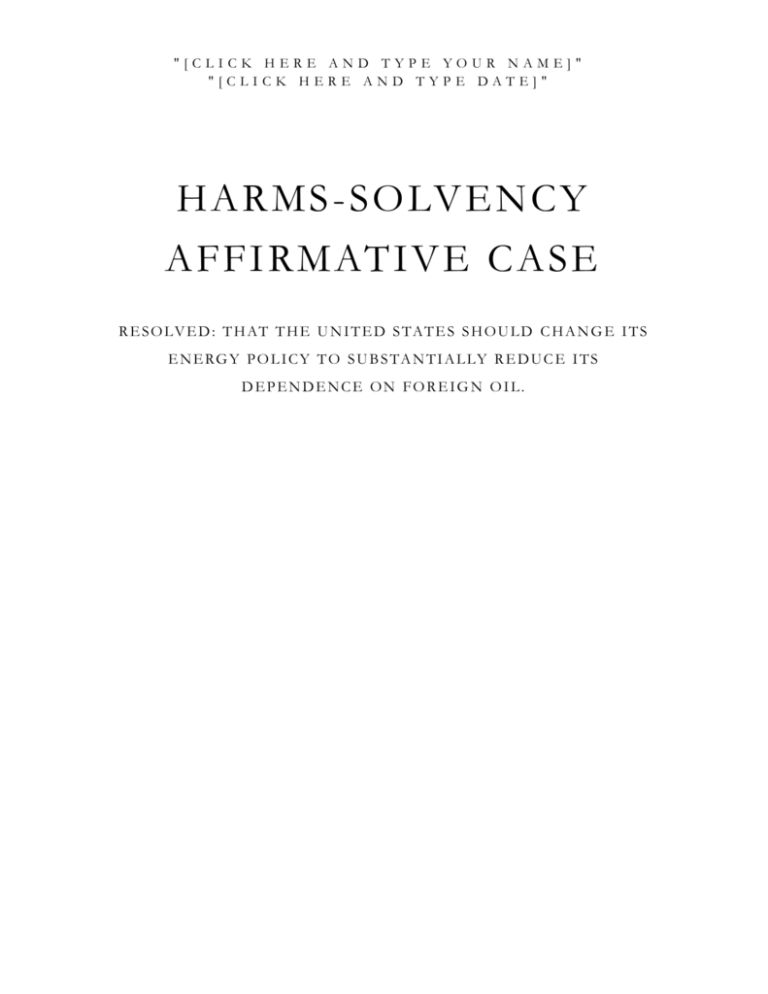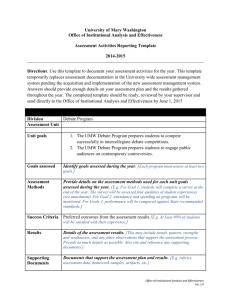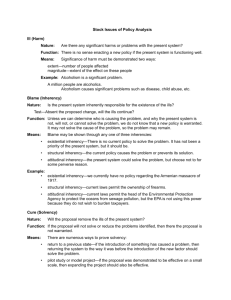How to Use This Template - Homeschool
advertisement

"[CLICK HERE AND TYPE YOUR NAME]" "[CLICK HERE AND TYPE DATE]" H A R MS -S O LV E N CY A FFI RM ATI VE C A SE R E S O L V E D : T H A T T H E U N I T E D S TA T E S S H O U L D C H A N G E I T S E N E RG Y P O L I C Y T O S U B S TA N T I A L LY R E D U C E I T S DEPENDENCE ON FOREIG N OIL. How to Use This Template Welcome to Training Minds Ministry's Harms-Solvency Affirmative Case Template. We hope you find this template useful in creating your debate case. This template is designed to be used alongside TMM's Blue Book (U.S. Energy Policy: Debating the 2004-2005 Homeschool Resolution), Vance Trefethen's Strategic Debate, and/or TMM's Midseason Briefs. If you do not have these publications, ctrl + click here. The Blue Book has 13 debate cases, one of which is offered free online (ctrl + click here to view). You can refer to these cases as models on how to write your own case. This template is one of many ways you can outline a debate case. Change the information on this template to contain the information you would like. For the body of your case, use Styles such as Heading 1-5, Body Text, Block Quotation, List Bullet, and List Number from the Style control on the Formatting toolbar. For evidence quotations, use Styles such as Contention, Citation and Evidence "Char" (abbreviation for "Characters"). This report template is complete with Styles for a Table of Contents and an Index. From the Insert menu, choose Reference, Index and Tables. Click on the tab you would like. How to Customize This Report This template is a tool to use to get you going on debate case development, but it is important to note that this template isn't the only way to write a debate case. Don't think you need to stick with TMM's version of this template. You are free to modify this template as much as you want. To create your own customized version of this template, select File New General Templates and choose this template. Be sure to indicate "template" as the document type in the bottom right corner of the dialog. You will then be able to make changes and save the template with a custom name. 1) Insert your name and the date in place of the text on the cover page by clicking once and typing. 2) Choose File Save As. At the bottom of the menu, choose Document Template in the Save File as Type: box. (The filename extension should change from .doc to .dot.) Save the file under a new name to protect the original version, or use the same template name to replace the existing version. When Finished When you are finished writing your case, take the time to read it aloud, timing yourself along the way. Your case should be read smoothly (no speed reading) within an 8-minute constructive. Be sure to use a convincing voice as you are giving a polished rhetorical speech to the judge. You may find that you need to cut a little here, revise a little there, do whatever needed to make your debate case persuadable and convincing. Standard Debate Case - 2 Have Your Case Critiqued! Don't settle with having your only critique be your bedroom mirror. Read it to your parents, your siblings, your classmates and your coach. You have worked hard on your case so far, but you must understand that you may have your blinders as you are intensely involved. Others may see some obvious flaws that you are not able to see, so be open to constructive criticism. Think about what your audience is saying, and ask yourself how their observations can make your case more convincing. All cases should change quite a bit from the first draft and especially after the first time debated. Champion debaters never let their case remain the same; they are always modifying and revising. In fact, this is a secret to their success! Don't Stop Here Don't ever think you have a fool-proof case. You don't, no matter how good you think it is. In fact, jump the gun and start writing a negative brief against your own case. Surely you came across evidence that argued against your case. Keep this evidence and write briefs that attack your case. Then write defenses to these briefs. This will prepare you for the tournament when you hear these arguments from your opponents. Standard Debate Case - 3 AFFIRMATIVE TITLE USE THIS SPACE TO TY PE A THESIS STATEMEN T THAT EXPLAINS IN ONE OR TWO SENT ENCES YOUR ENTIRE CASE. Write your introduction. Though this appears at the beginning of your case, you may want to wait to write this till you have filled out the rest of your case. An introduction gives a general preview of your case as well as provides the opportunity to persuade the judge in principle. You will be leading the judge through a structured, 8-minute argument, so present the introduction in simple terms that will give the judge a general understanding of where you are taking this. OBSERVATION 1. TOPICALITY: THE AFFIRMATIVE CASE MEETS A REASONABLE DEFINITION OF THE RESOLUTION A. Definitions Here you want to define the various terms within the resolution, as the Blue Book goes into detail explaining. B. Analysis Take the time to analyze the resolution. This is the attempt by your team to assess the resolution for what it says and give confidence to the judge that your case is topical. OBSERVATION 2. HARMS The harms of the case shows that these flaws in the status quo (the inherency you just proved) are significantly harmful (often referred to as significance). Just like with inherency, the evidence should be properly cited and should support the case's thesis. A. X is happening to the status quo Citation Evidence B. X causes Y (Y = loss of human rights, economic loss, death, sickness, etc.) Citation Evidence C. X causes Z (another negative impact) Citation Evidence Standard Debate Case - 4 OBSERVATION 3. INHERENCY This section will be backed up with evidence that shows that the status quo is flawed. The important thing to prove is that a change in policy is needed, not just a simple fix of the current policy. This can be done using Supreme Court cases, governmental documentation, periodical opinions, and the like. All evidence used to prove inherency should be properly cited and should support the case's thesis. A. Current policy is X Citation Evidence B. X is failing Citation Evidence C. Attempts to fix X are not working Citation Evidence To solve these harms, we offer the following plan. Here you will give your plan to solve the harms you just presented. You do this by presenting a number of "planks," which are given implementations to your overall plan. Like the contentions of your observations, your planks must be topical and should be written to support your thesis. Plank 1 Write your plank here. Plank 2 Write your plank here. Plank 3 Write your plank here. Plank 4 And so on… OBSERVATION 4. SOLVENCY Solvency does exactly what the term implies: it solves the case. The contentions provided in the solvency often directly relates to your case's harms and inherency. Harm 1 often is solved with contention 1 of solvency, and so on through this section. Continue to support your thesis with every contention, never veering into extra-topical areas. A. Subpoint 1 Citation Evidence Standard Debate Case - 5 B. Subpoint 2 Citation Evidence Now take the time to write your conclusion. You may want to state, word-for-word, the thesis of your entire case. Revisit your introduction and ask yourself, "How does this case convince the judge that the plan should be implemented?" Then write this argument down in the conclusion. Standard Debate Case - 6








